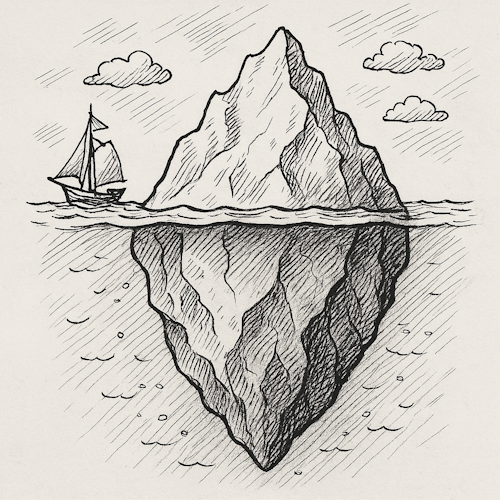The Iceberg Model
Illustrates Systems Thinking, Root Cause Analysis, Cultural Awareness
Many agile teams struggle not because of what is visible, but because of what lies beneath. Symptoms like missed deadlines, low engagement, or quality issues often trigger immediate reactions. But what if these challenges are just the tip of the iceberg? The Iceberg Model invites us to look deeper. It is a tool to help agile practitioners and leaders shift from reacting to symptoms to addressing root causes and systemic patterns.

In a quiet harbor town, a team of shipbuilders faced a troubling problem. Every few months, one of their boats would return damaged. Sometimes it was a cracked hull. Other times, broken masts or ruined cargo. The crews blamed storms. The engineers blamed weak designs. The owners blamed poor craftsmanship.
One day, an old mariner named Ansel visited the shipyard. He had spent decades at sea and listened quietly as each group argued their case. Finally, he asked a simple question.
"Have any of you asked where the damage begins?"
Confused, the team showed him blueprints, maintenance records, and weather charts. Ansel shook his head. "You're looking at the boat. I'm asking about the water."
He took them to a nearby dock and pointed out into the bay. "Do you see that ridge of calm water? That is not calm. That is an iceberg, mostly hidden beneath the surface. When the tide shifts, it drifts just enough to scrape the hull."
The team stared, silent.
"You are fixing the boats," Ansel said, "but not the reason they break."
From that day forward, the shipbuilders tracked underwater patterns before launch. They mapped tides. They studied hidden risks. The damage did not stop overnight, but it slowed, then faded. By looking beneath the surface, they had changed more than boats. They had changed how they worked.
Lessons Learned
What You See Is Not All There Is
Teams often focus on surface-level issues like bugs, lowered velocity, or delays. But these are outcomes. Real understanding comes from exploring patterns, structures, beliefs, and mental models that create those outcomes. The Iceberg Model helps Agile teams and leaders move from firefighting to systems thinking.
Patterns Reveal More Than Events
Ansel's question reframed the situation. Instead of chasing isolated events, the team began to see recurring damage. Agile teams can apply this same thinking. Instead of fixing a single bug or conflict, look for trends across Sprints or teams. What keeps happening, and why?
Culture and Mindsets Drive Behavior
The iceberg's base represents mental models, assumptions, and values. These are the hardest to see but the most powerful. If teams operate in fear, rush through Retrospectives, or avoid conflict, those behaviors often reflect deeper beliefs. Without surfacing and addressing them, change efforts remain shallow.
Surface Fixes Rarely Solve Systemic Issues
Patching problems without addressing root causes leads to burnout and frustration. The shipyard crew kept repairing boats until someone asked the right question. Agile teams should use tools like the Five Whys, systems diagrams, and Retrospective data to dig deeper.
Language Shapes What Gets Noticed
Ansel used metaphors to invite new thinking. Where does the damage begin became a powerful reframing tool. Agile coaches can use language this way, helping teams see hidden connections and change the questions they ask themselves.
Awareness Is a Skill
The Iceberg Model encourages pause and observation. It trains teams to look below the surface even when pressure demands speed. This is a critical skill in fast-moving environments. Slowing down to understand can ultimately save time, energy, and trust.
Coaching Tips
- Introduce the Iceberg at Retrospectives: Use a simple sketch or template to help teams categorize issues. Start with visible events, then explore patterns, structures, and beliefs.
- Model Curiosity over Blame: When issues arise, shift from "Who caused this?" to "What system led to this?" This builds safety and shifts attention to long-term improvement.
- Help Leaders See the Hidden Layers: Leaders often react to what they can measure. Help them understand how invisible forces like culture, trust, and mental models shape visible results.
- Use the Parable to Prompt Insight: Ask teams, "What is our iceberg?" or "Where does the damage really begin?" Let the metaphor create space for reflection.
The Iceberg Model reminds us that effective Agile work requires depth. Teams that stay at the surface solve symptoms. Teams that explore beneath it transform systems. Whether you are a Scrum Master, Product Owner, or Agile Coach, the invitation is the same: look deeper, ask better questions, and help your team see what truly needs to change.
What lies beneath your team's iceberg?


